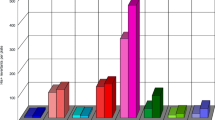Abstract
The mutation frequencies attributable to −1 frameshift or one-base substitution in the structural genes coding for resistance to chloramphenicol (Cm) and tetracycline (Tc) were followed over several cycles of DNA replication, and found to differ several-fold, depending on the orientation of the gene on the plasmid with respect to the direction of (unidirectional ColE1-type) replication. The mutation frequency was higher when the reporter gene was present in the plasmid in the same orientation as the direction of the origin, i.e., when the transcription template is the lagging daughter strand, than when the gene was inserted in the opposite orientation. This significant difference in reversion frequencies of genes with different polarities was demonstrated only for a brief period of cell growth (several cycles of replication) after induction of thednaQ49 mutator, but was not observed when an increased number of replication cycles, was permitted, most probably due to fixation of the mutation into both strands. The mutated intermediate DNA which possesses a misaligned basepair in the Cm gene was demonstrated to be replicated into two progeny DNA molecules; one is the chloramphenicol-resistant (CmR) DNA synthesized from the template strand having the mutation and the other is the Cms DNA from the template strand without mutation. Our results suggest that replication-dependent mutagenesis may occur preferentially in the lagging strand.
Similar content being viewed by others
References
Backman K, Boyer HW (1983) Tetracycline resistance determined by pBR322 is mediated by one polypeptide. Gene 26:197–203
Balbás P, Soberón X, Merino E, Zurita M, Lomeli H, Valle F, Flores N, Bolivar F (1986) Plasmid vector pBR322 and its special-purpose derivatives. Gene 50:3–40
Bedbrook JR, Lehrach H, Ausubel FM (1979) Directive segregation is the basis of ColE1 plasmid incompatibility. Nature 281:447–452
Brewer BJ (1988) When polymerases collide: replication and the transcriptional organization of theE. coli chromosome. Cell 53:679–686
Chang ACY, Cohen SN (1978) Construction and characterization of amplifiable multicopy DNA cloning vehicles derived from the P15A cryptic miniplasmid. J Bacteriol 134:1141–1156
Christie GE, Farnham PJ, Platt T (1981) Synthetic sites for transcription termination and a functional comparison with tryptophan operon termination sitesin vitro. Proc Natl Acad Sci USA 78:4180–4184
Furusawa M, Doi H (1992) Promotion of evolution: disparity in the frequency of strand-specific misreading between the lagging and leading DNA strands enhances disproportionate accumulation of mutations. J Theor Biol 157:127–133
Greener A, Callahan M (1994) XLI-Red: a highly efficient random mutagenesis strain. Strategies 7:32–34
Horiuchi T, Maki H, Sekiguchi M (1978) A new conditional lethal mutator (dnaQ49) inEscherichia coli K12. Mol Gen Genet 163:277–283
Horiuchi T, Maki H, Sekiguchi M (1989) Mutators and fidelity of DNA replication. Bull Inst Pasteur 87:309–336
Maki H, Horiuchi T, Sekiguchi M (1983) Isolation of conditional lethal mutator mutants ofEscherichia coli by localized mutagenesis. J Bacteriol 153:1361–1367
Marians KJ (1992) Prokaryotic DNA replication. Annu Rev Biochem 61:673–719
Maruyama M, Horiuchi T, Maki H, Sekiguchi M (1983) A diminant (mutD5) and a recessive (dnaQ49) mutator ofEscherichia coli. J Mol Biol 167:757–771
Mellon I, Hanawalt PC (1989) Induction of theEscherichia coli lactose operon selectively increases repair of its transcribed DNA strand. Nature 342:95–98
Mellon I, Spivak G, Hanawalt PC (1988) Selective removal of transcription-blocking DNA damage from the transcribed strand of the mammalian DHFR gene. Cell 51:241–249
Mulligan ME, Hawley DK, Entriken R, McClure WR (1984)Escherichia coli promoter sequences predict in vitro RNA polymerase selectivity. Nucleic Acids Res 12:789–800
Roberts JD, Nguyen D, Kunkel TA (1993) Frameshift fidelity during replication of double-stranded DNA in HeLa cell extracts. Biochemistry 32:4083–4089
Rosche WA, Trinh TQ, Sinden RR (1995) Differential DNA secondary structure-mediated deletion mutation in the leading and lagging strands. J Bacteriol 177:4385–4391
Scheuermann R, Tam S, Burgers PMJ, Lu C, Echols H (1983) Identification of ε subunit ofEscherichia coli DNA polymerase III holo enzyme as thednaQ gene product: a fidelity subunit for DNA replication. Proc Natl Acad Sci USA 80:7085–7089
Takahashi-Fuji A, Ishino Y, Shimada A, Kato I (1993) Practical application of fluorescence-based image analyzer for PCR single-stranded conformation polymorphism analysis used in detection of multiple point mutations. PCR Methods Applic 2:323–327
Thomas DC, Nguyen DC, Piegorsch WW, Kunkel TA (1993) Relative probability of mutagenic translesion synthesis on the leading and lagging strands during replication of UV-irradiated DNA in a human cell extract. Biochemistry 32:11476–11482
Trinh TQ, Sinden RR (1991) Preferential DNA secondary structure mutagenesis in the lagging strand of replication inE. coli. Nature 352:544–547
Veaute X, Fuchs RPP (1993) Greater susceptibility to mutations in lagging strand of DNA replication inEscherichia coli than in leading strand. Science 261:598–600
Vieira J, Messing J (1987) Production of single-stranded plasmid DNA. Methods Enzymol 153:3–11
Yanisch-Perron C, Vieira J, Messing J (1985) Improved M13 phage cloning vectors and host strains: nucleotide sequence of the M13mp18 and pUC19 vectors. Gene 33:103–119
Wada K, Doi H, Tanaka S, Wada Y, Furusawa M (1993) A neo-Darwinian algorithm: asymmetrical mutations due to semicon-servative DNA-type replication promote evolution. Proc Natl Acad Sci USA 90:11934–11938
Author information
Authors and Affiliations
Additional information
Communicated by M. Sekiguchi
Rights and permissions
About this article
Cite this article
Iwaki, T., Kohno, K., Kano, Y. et al. Preferential replication-dependent mutagenesis in the lagging DNA strand inEscherichia coli . Molec. Gen. Genet. 251, 657–664 (1996). https://doi.org/10.1007/BF02174114
Received:
Accepted:
Issue Date:
DOI: https://doi.org/10.1007/BF02174114




